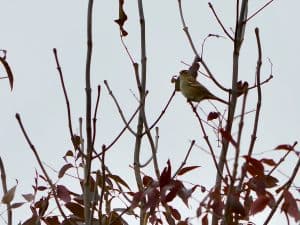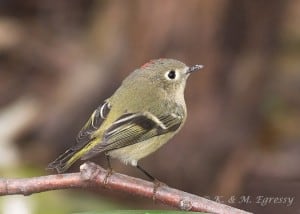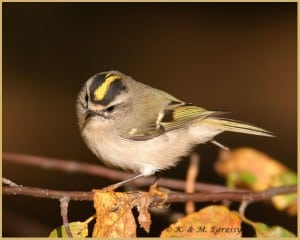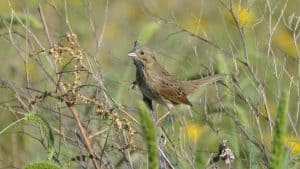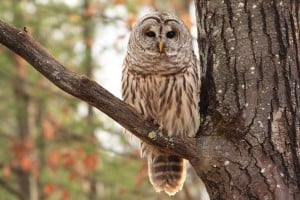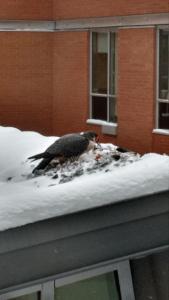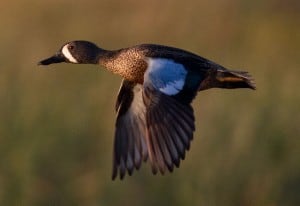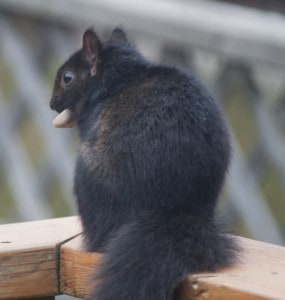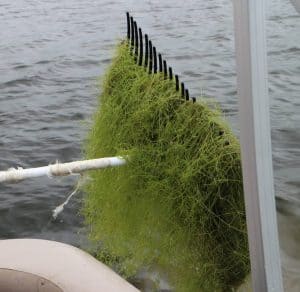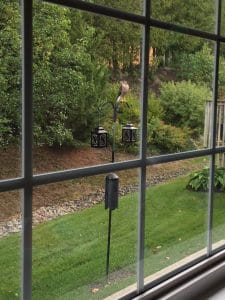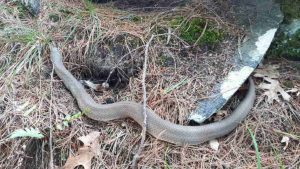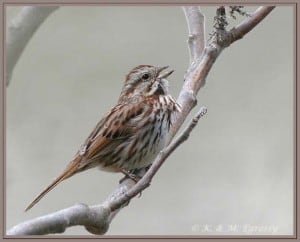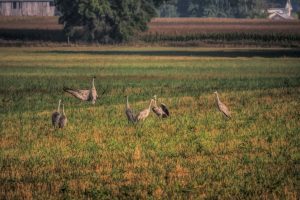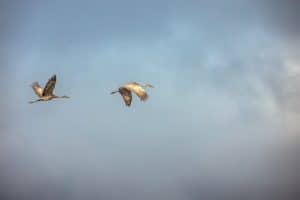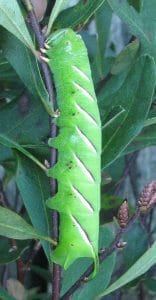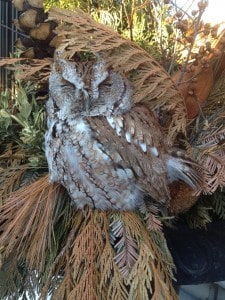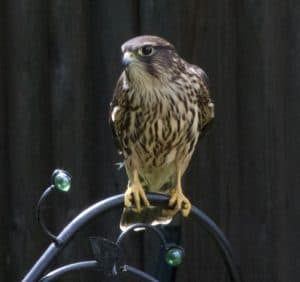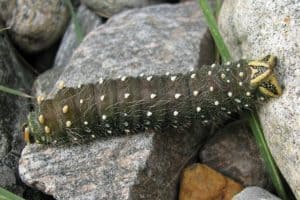Peterborough Field Naturalists Sunday AM Nature Walk (Sept. 30)
Today, a group of us walked along the hydro corridor west of Hetherington Dr. (just south of Woodland) and into the north end of University Heights Park. We enjoyed the abundant asters (e.g., New England, Heath, Panicled, Heart-leaved), Zig-Zag Goldenrod, White Baneberry with its doll’s-eye fruit and a single Jack-in-the-Pulpit with its ball of red fruit. Birds of interest included White-throated Sparrow (20), White-crowned Sparrow (1), Song Sparrow (12), Ruby-crowned Kinglet (1), Golden-crowned Kinglet (1), Eastern Towhee (1), Nashville Warbler (1), Palm Warbler (1), Belted Kingfisher (1), Pileated Woodpecker (1), Northern Flicker (1) and Yellow-bellied Sapsucker (1). Earlier, we found a single Swainson’s Thrush on the Parkway Trail, just south of Cumberland Drive. Drew Monkman
Lincoln’s Sparrow (2) via eBird
– Reported Sep 30, 2018 07:36 by Donald A. Sutherland
– Peterborough–Trent Rotary Rail Trail, Peterborough, Ontario
– Map:
– Checklist:
Barred Owl (1) via eBird
– Reported Sep 27, 2018 13:01 by Daniel Williams
– Ingleton-Wells Property (Kawartha Land Trust), Peterborough, Ontario
– Map:
– Checklist:
Peregrine Falcon (1) via eBird
– Reported Sep 27, 2018 08:12 by Iain Rayner
– Peterborough–Millennium Park, Peterborough, Ontario
– Map:
– Checklist:
– Comments: “Large adult eating bird atop 300 Water St.”
Blue-winged Teal (2) via eBirds
– Reported Sep 23, 2018 10:36 by Rene Gareau
– Lakefield–Sewage Lagoons, Peterborough, Ontario
– Map:
– Checklist:
Squirrels hoarding rocks: I just found your site and wanted to add my comments regarding gray & black squirrels stealing rocks. Here in Chilliwack, BC we have been observing squirrels stealing hundreds of rocks every fall and winter. They steal all sizes, types, and work all day to take away their treasure. This usually starts when seasons change with wet and cooler days arriving. I think they hoard the rocks to stabilize their dreys and also putting the flat ones inside the nest to warm the bed over the winter for the young when they are born and vulnerable. I’m basing this on many hours of watching squirrel behavior from our living room which faces a heavily forested back garden. My husband and I are constantly renewing our landscaping rocks with humour at the hard work of these amazing little critters. Jenne Breedon, Chilliwack, BC
(Note: For other reports on this behaviour, see November 30, 2014 )
Lincoln’s Sparrow (2) via eBird
– Reported Sep 23, 2018 13:53 by Luke Berg
– LHT Redmond Rd to Drummond Line , Peterborough, Ontario
– Map:
– Checklist:
Starry Stonewort, a new aquatic invasive species: I want to let you know about a (new to me) threat to our Kawartha Lakes. A macro algae has infested Lake Scugog and is now thriving in parts of Stony, notably the Lost Channel. Starry Stonewort has no roots and forms masses up to six feet deep floating below the surface. Carol Cole, a cottager on Stony Lake writes: “It was first noticed there a couple of summers ago. The channel is not open water really; it is more of a wetland environment. The alga is now covering large sections of the wetland and has spread incredibly quickly into the bays on either end. One of the bays is now almost totally covered. It used to be a very weedy area but now it looks clear of weeds – unless you look down. The bay at the other end isn’t quite as bad but it will be by next summer. Both of these bays lead directly to the main boating channel of the Trent-Severn Waterway. Both have cottages and boat traffic. Not far from the bay already covered is a wetland that has been declared provincially significant. Starry Stonewort spreads by fragmentation and the only way to stop it from spreading to other lakes is to clean, dry and drain out boats, canoes or kayaks before leaving the lake. Since this is already in Stoney Lake there isn’t anything we can do about it. All we can do now is prevent it from reaching other lakes. ”
Please spread the word! Sandra Burri, Kawartha Park, Clear Lake
More about Starry Stonewort: CLIMATE CHANGE REALITY IN SCUGOG SHOULD CHANGE OUR PEOPLE-CENTRIC VIEW OF OUR LAKE. Ours is a shallow lake held at its current height by a dam at Lindsay. As a result of increased temperatures, increased storm water runoff, difficult invasive species due to our location in Southern Ontario and increased development, ours is an ecosystem that is vulnerable and susceptible to change. This year, the lake has generally been excellent for recreation and surface aesthetics because of a vast understory of the invasive alga, Starry Stonewort (SS) and abundant zebra mussels that enjoy co-habiting with SS. But is this good habitat for everything else that lives in, on or above the lake? The Stewards and our colleagues at U.O.I.T. and Kawartha Conservation are studying this new invader which seems to be spreading rapidly up throughout the hard-water Kawartha Lakes and Lake Simcoe. We have one more year in our Trillium grant funding for research, but we hope to extend our research for two more years, trying to ascertain the Ontario-wide spread and effects of this nasty invader. Use a rake to pull up a sample from the lake bottom. If you find a crunchy, green fishing line type bottom cover that is the algae — Starry Stonewort. CLEAN, DRAIN, DRY your boat before coming into, or going out of, Lake Scugog. Scugog Lake Stewards, City of Kawartha Lakes
Cooper’s Hawk: We have a bird feeder outside our condo living room at the corner of Parkhill and Ravenwood Dr. On September 21, we were able to get this picture of a Cooper’s Hawk. We had never seen this bird before. John & Stephanie MacDonald
Eastern Hog-nosed Snake: My nephew and sister came across this Eastern Hog-nosed Snake recently at Wolf Lake near Apsley. Bill Astell, Peterborough
(Note: The Eastern Hog-nosed is a species at risk in Ontario and only rarely seen. DM)
A “dew” bath: I witnessed something absolutely new for me on the morning of September 18. At about 7:30 am, I saw two Song Sparrows giving themselves a bath in the heavy dewed grass. They burrowed down and splashed the dew on by rapidly flicking their wings onto their backs. Michael Gillespie, Keene
Sandhill Cranes: It is that time again when the Sandhill Cranes begin to gather before migrating south. In the area west of Lindsay (Black School Rd area) the gathering has already started. These pictures were taken on September 18. Tim Corner
Poecila Sphinx: On Friday, September 14, we came across the caterpillar of the Poecila Sphinx Moth (also called Northern Apple Sphinx). It measured about two inches long. We had never seen one before. The caterpillar was on a Sweet Gale bush, a species that dominates the banks of the Indian River near our home. This plant can be used as an insecticide, can treat scabies, used with discretion to flavour soups and stews, flavours Gale beer, repels fleas, and the roots and bark produce a yellow dye for wool. Quite a list! The scent on the leaves was rather faint when I checked but given the time of year that’s not surprising. Stephenie Armstrong, Warsaw
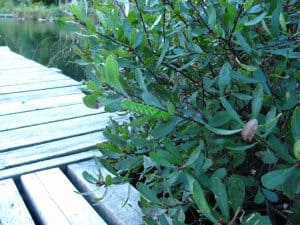
Poecila Sphinx Moth caterpillar on Sweet Gale shrub – Indian River – September 2018 – Stephenie Armstrong
Eastern Screech-Owl (via eBird): – Reported Sep 13, 2018 20:10 by Patrick Scanlon- Indian River Road., Peterborough, Ontario- Map: – Checklist: – Comments: “Singing from the west side of the river.”
Merlin: My husband, Michael, noticed this Merlin while we were having lunch on September 13. We watched it for about 10 to 15 minutes. It was looking at our bird feeder (and doing a bit of head bobbing) from the top of the umbrella of our outdoor picnic table. A few minutes later it landed right on top of the bird feeder. Our feeder has been quite active with American Goldfinches, Purple Finches, chickadees, cardinals, a few jays and some sparrows. The bird sort of half-heartedly swooped downward toward a scurrying squirrel before it left our yard. There were no smaller birds during the time of the visit of the Merlin. Not surprising. It was very cool!! Helen Bested, Lynhaven Road, Peterborough
Imperial Moth caterpillar: On September 7, this Imperial Moth caterpillar, a member of the Giant Silkworm Moth family, was making its way along our side path, heading for river rocks abutting a flower bed. I gather it feeds on a variety of plants including pines and oaks which we have in abundance. And later that day, I saw another one floating vertically, head out of water, in our small creek that empties into the Indian River. I managed to retrieve it but there was no sign of life. I hope one day to actually see this beautifully colored moth, though it is said to be in decline. As you have explained in your book ‘Nature’s Year’, it is extremely attracted to light making it highly visible to predators. Stephenie Armstrong, Warsaw
